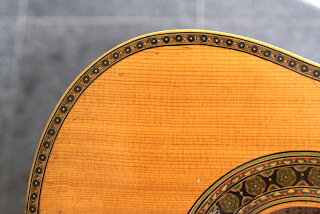To make things clear I will explain the choice of the pieces played on this CD.
- The Menuet: This is quite an easy piece to play for most guitarplayers so
they will have the opportunity to make comparisons of the three instruments
used on the CD for this piece but also involve their own instrument.
- The Sarabande in fact belongs to the Menuet because it was most likely
composed by the same author. I find this piece more refined as the more
straightforward Menuet and you are able to make more tonecolouring
because of the lower speed in which it should be performed.
- Vivace composed by Adam Falckenhagen is a sparkling compostion and
has some really nice elements in it. This work can also be found in
"The baroque Guitar" by Frederic Noad.
- The Gavotte composed by J.S. Bach requires more skills and one way or
another is tiresome for my hands. That's the reason I didn't play the repe-
titions though in fact it would have been easy to copy and paste the parts.
- Air is a very well known piece this time for guitar solo. I think I will pleasure
many people with it and it has another goal: performing this piece at funerals
has a kind of a healing effect on those people concerned.
- Lagrima can be regarded as Francesco Tarrega's most famous piece and
a lot of classical players can actually play it by head and use it as a piece
for judging different guitars. It has all elements involved when it comes to
judging an instrument: the higher notes as well as the basses.
- Adelita in fact has the same qualities in that aspect but being a piece that
needs to be performed slower it even has more sense when judging the
different instruments.
- Endecha, Maria and Prelude nr. 5 are pieces not too well known by the
audience while in fact they deserve better. Judge for yourself.
Prelude is in fact a short piece but it offers the opportunity to give it
a slightly slower middle piece that is in minor which makes it a mini concerto.
- Petenera is a piece from the somewhat forgotten composer Sainz de la Maza.
He was a gifted player as well and combines folky elements with a more
classical approach. Also some Flamenco-like are there. I particularly like
the second half of this piece as the bass movement is really interesting.
- Valse Criollo from the composer Antonio Lauro is a piece with lots of
qualities in it but besides that it is a challenge for every classical guitarplayer.
You will find two versions of this piece: The first one played on the Ramirez
and the second one on the Vicente Arias guitar somewhat faster.
In my opinion it is a difficult piece for the average listeners: There is
happening a lot and so fast! I tried in playing this piece to make the
construction clear and it was my choice to play the second part a bit slower.
- The Pavane by Antonio Lauro came together with the music of Valse Criollo.
so I figured to give it a try. By studying this piece on and on, I learned to discover
the beauty of it and its' consistency, though the sequences of the chords were quite
difficult to understand at first.
- Verano Porteno from the South American composer Astor Piazolla is a piece
I particularly like: It has all the elements of making music for me: Rythm, passion
and in fact a lot of freedom as Piazolla performed it in so many different ways.
- Scarborough Fair happened to come back to me as I allways liked the
chordsequence of the beginning but I never attempted to play it myself.
Being a piece my mother liked to sing and then of course in the Simon and
Garfunkel version I decided to put in on this CD.
- Classical Gas by Mason Williams awakened my interest in classical music
and I allready did a lot of attempts to play it when I was young. In spite
of the Tommy Emmanuel version I decided it to be my last version
presented here. Without the trumpet part...
- Etude recorded by Lee Ritenour is a piece we allready played with our
band but it has enough interesting elements to perform it on guitar solo.
Lee Ritenour of course is a celebrated studio musician and has a lot of
qualities in different fields. However I think I've added something by playing
his piece with a more classical tone.
- Kiss from a Rose sung by Seal is a song with a lot of emotion in it but his
version on record is a little bombastic. His live performance sometimes is
so much more intimate that I decided to play it on guitar solo.
The guitar alone can do the job to my opinion. The strength of the song remains!
- Paris Texas from Ry Cooder is a beautiful song with so much loneliness
in it. For that reason I allways liked it but I just recently play it myself.
That has everything to do with an auction I visited and somewhere
hidden in a dirty cover there was this original National Havana guitar.
As I allways wanted to have a guitar like that I decided to bid on it a
few days later and I must say I was pretty nervous at that time.
I got it at an extremely low price!
- The two menuet executions I've added have been played on different guitars
so the listener is able to hear the differences between the guitars used.
- The remaining pieces share the same goal with the exception of Valse Criollo
because I wanted to have a faster version on my CD and on another guitar.














